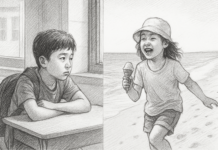-

When it comes to the end of autumn, Hanoians know it is time to eat Cha Ruoi, a special dish that you can only taste at a certain time during a year, and the season for it only lasts a few days. Hanoi’s Cha Ruoi is made from Ruoi, a kind of sea worm commonly called ragworm or clamworm. The worms spend much of their short lives in brackish water burrowing into the sand or mud. Their hue changes from pinkish purple to milky brown as it matures. When their belly is filled with milky fluid, it is time for the worms to leave their shelter for the spawning grounds. (Photo: VietnamPlus)
-

Hanoi is not the home land of Ruoi (rag worm) but local people have created a delicious dish from the creature, which is Cha Ruoi (deep fried ragworm patties). The dish has for long become well known in the country. The patties are best eaten in cold weather, which is also the harvest time of Ruoi. The worms spend much of their short lives in brackish water burrowing into the sand or mud. When their belly is filled with milky fluid, the worms leave their shelter en mass for the spawning grounds. Fishermen catch the creatures when they appear following a rising tide, floating on the surface of the water in the spawning season in late September or early October. (Photo: VietnamPlus)
-

Located on No. 1 Hang Chieu Street, a corner where Hang Chieu street intersects with the beginning of O Quan Chuong street in the Old Quarter downtown Hanoi, Mrs. Nham’s Cha Ruoi restaurant is always crowded with customers, who favour this specialty dish. The Ruoi season lasts only several days in late September or early October, depending on the weather. Fishermen catch Ruoi when they appear en masse following a rising tide, floating on the surface of the water in the spawning season. It seems that worms are a strange ingredient for a dish. However, with their creativity, experience and skillful hands, local cooks can turn such ingredient into an emotive delicacy for gastronomy lovers. (Photo: VietnamPlus)
-

A close look at the live Ruoi. Cha ruoi (deep fried ragworm patties), though made from the humble creatures from the countryside, is considered a gift that nature bestows upon the northern countryside of the nation. The worms are mixed with minced lean pork, chicken eggs, tangerine peels, scallions, and dil. The mixture is then shaped into patties and deep fried. The patties taste a little fatty and greasy, but sweet and crunchy at the same time, with mouth-watering aroma, making it a culinary delight. As the Ruoi season is short, Cha Ruoi used to be a special dish that was available only at a certain time in a year. (Photo: VietnamPlus)
-

Ruoi is the Vietnamese name of a kind of sea worm commonly called ragworm or clamworm. Though the worm, which has many hairs, can look scary at first glance, it is a famous specialty in the Vietnamese culinary map. The worms spend much of their short lives in brackish water burrowing into the sand or mud. When their belly is filled with milky fluid, the worms leave their shelter en mass for the spawning grounds. Fishermen catch the creatures when they appear following a rising tide, floating on the surface of the water in the spawning season in late September or early October. As the Ruoi season is short, Cha Ruoi used to be a special dish that was available only at a certain time in a year. (Photo: VietnamPlus)
-

Once you have tried the delicious taste of dishes made from ragworm, the feeling of fear would surely disappear. Many people are scared of the worm due to its appearance at first but then they soon get addicted to the food made from it. The patties taste a little fatty and greasy, but sweet and crunchy at the same time, with mouth-watering aroma, making it a culinary delight. Before becoming part of a meal, the worms must be cleaned thoroughly. All their hairs must be removed to take away the unpleasant smell and other discomforts for eaters. Once cleaned, they are mixed with minced lean pork, chicken eggs, tangerine peels, scallions, and dill. (Photo: VietnamPlus)
-

Besides Ruoi, other materials for making good Cha Ruoi (deep fried ragworm patties) include a small amount of minced lean pork, chicken eggs, tangerine peels, scallions, and dill. All materials should be mixed thoroughly with fish sauce until the mixture becomes sticky and pliable. The herbs, particularly tangerine peels, are the ‘secret’ to give the patties a delicate and sweet taste, as they help remove the last of the sea worms’ unpleasant odor, add more flavour to the final taste, and make the dish easier to digest. The mixture should be well mixed until becoming sticky and consistent. Cha Ruoi is best eaten in cold weather. It is one of the most popular ragworm dishes in Hanoi. (Photo: VietnamPlus)
-

The mixture of Ruoi, minced lean pork, chicken eggs, tangerine peels, scallions, and dill is divided into patties that are neither too thick nor too thin. The next step is to heat up a frying pan and add some oil or lard from pig, preferably the latter as it augments the final taste. The patties are then submerged in hot fat and slowly fried. The perfectly fried patties are golden brown but not dry. They should be served hot with a little pepper sprinkled on them. The dip that accompanies a dish of cha ruoi consists of fish sauce, chili, sugar and lemon juice. (Photo: VietnamPlus)
-

Cha ruoi (deep fried ragworm patties) is usually fried slightly at the restaurants. When a customer orders the dish, the patties will be fried again so that they are served crunchy and hot. Customers can also bring the patties home and fry them just before eating. The greasy patties have the mildly bitter taste from the tangerine peels as they are a mix of the sea worms with a small amount of minced lean pork, chicken eggs, tangerine peels, scallions, and dill. They should be served hot with a little pepper sprinkled on them. The dip that accompanies a dish of Cha Ruoi consists of fish sauce, chili, sugar and lemon juice. (Photo: VietnamPlus)
-

Under the skillful hands of local grandmothers and mothers, the hairy and scary sea worms are turned into delicious and typical dishes of the capital every late autumn. The Ruoi patties taste a little fatty and greasy, but sweet and crunchy at the same time, with mouth-watering aroma, making it a culinary delight. Before becoming part of a meal, the worms must be cleaned thoroughly. In the past, Cha Ruoi was only available during the season, which lasts just a short time. But now with the help of refrigerators, the worms, once cleaned, can be kept frozen for up to a year and used as required. However, the special dish is best eaten in cold weather, which is also the harvest time of the worms. (Photo: VietnamPlus)
-

Although Cha Ruoi (deep fried ragworm patties) is now sold in Hanoi all the year round, many foodies still wait until the right season in late autumn to enjoy the special dish. Hanoi is not the home land of ragworm (ruoi) but local people have created the delicious Cha Ruoi (deep fried rag worm patties), which later became well known everywhere. Ruoi is the Vietnamese name of a kind of sea worm that live in brackish water. They spend much of their short lives burrowing into the sand or mud. When their belly is filled with milky fluid, the worms leave their shelter en mass for the spawning grounds, usually in late September or early October. (Photo: VietnamPlus)
-

The gentle wind and mild sunlight coupled with the dry weather in late autumn and early winter make the dish “go right into the heart” of diners in the days in between the two seasons. For many foodies, it is a must to eat Cha Ruoi at this time of the year. Anyone passing by a Cha Ruoi restaurant on Hanoi’s streets cannot help notice immediately the strong and yummy smell of the patties frying in hot oil in a big pan. Cha Ruoi, which combines the worm with small amount of minced lean pork, chicken eggs, tangerine peels, scallions, and dill, presents a delicate and sweet taste. (Photo: VietnamPlus)
-

In the past, Mrs. Nham’s restaurant used to sell Cha Ruoi (deep fried ragworm patties) only in the Ruoi season, but due to the demand of customers, the restaurant now offers the special dish all the year round. Located at No. 1 Hang Chieu Street, a corner where Hang Chieu street crosses the O Quan Chuong street in the Old Quarter downtown Hanoi, her restaurant is always crowded with customers, who are fans of this specialty dish. Ruoi is the Vietnamese name of a kind of ragworm or clamworm. The hairy creature can look scary for many at first glance. However, once you have tried the delicious taste of dishes made from the ragworm, the feeling of fear would surely disappear. Thanks to the skillful hands of local cooks, the worms have been turned into a delicacy. (Photo: VietnamPlus)
-

After being cleaned, ragworms are mixed with a small amount of minced lean pork, chicken eggs, tangerine peels, scallions, and dill. Then the mixture is beaten well, divided into patties and fried in pig lard on a hot pan, generating a smell that people hardly resist. The greasy patties have the mildly bitter taste from the tangerine peels as they are a mix of the sea worms with a small amount of minced lean pork, chicken eggs, tangerine peels, scallions, and dill. They should be served hot with a little pepper sprinkled on them. The dip that accompanies a dish of cha ruoi consists of fish sauce, chili, sugar and lemon juice. A Cha ruoi dish and its special sauce make a perfect hot food for cold weather in Hanoi. (Photo: VietnamPlus)
-

In order to secure the best fresh Ruoi, Mrs. Nham has to go to the central province of Nghe An, the northern province of Hai Duong and the norther port city of Hai Phong. Located on No. 1 Hang Chieu Street, a corner where Hang Chieu street intersects with the beginning of O Quan Chuong street in the Old Quarter downtown Hanoi, her restaurant is always crowded with customers, who are fans of this specialty dish. In the past, Mrs. Nham’s restaurant used to sell Cha ruoi (deep fried ragworm patties) only in the Ruoi harvest season, but due to the demand of customers, the dish is now available all the year round. (Photo: VietnamPlus)
-

Cha Ruoi (deep fried ragworm patties) is considered a specialty of Hanoi, so whenever coming to the Vietnamese capital city on the right time, visitors should hurry to enjoy it because this is when the food tastes best. Hanoi is not the home land of Ruoi (rag worm) but local people have created a delicious dish from the creature, which is Cha Ruoi (deep fried ragworm patties). The dish has for long become well known in the country. The patties are best eaten in cold weather, which is also the harvest time of Ruoi. To make Cha Ruoi, the worms are combined with a small amount of minced lean pork, chicken eggs, tangerine peels, scallions, and dill. (Photo: VietnamPlus)
-

Many tourists order Cha Ruoi to take home as a gift from Hanoi. Cha Ruoi is considered a specialty of the Vietnamese capital city. The gentle wind and sunlight coupled with the dry weather in late autumn and early winter make the dish “go right into the heart” of diners. Under the skillful hands of local cooks, the humble sea worms, which may be scary to look at, are turned into a delicious dish of the capital every late autumn. Anyone passing by a Cha Ruoi restaurant on Hanoi’s streets cannot help but immediately notice the strong and yummy smell of the Ruoi patties, especially when they are fried in the pans. (Photo: VietnamPlus)
-

The price of each Ruoi patty is rather high, ranging from 20,000 – 30,000 VND (0.88 – 1.31 USD) a piece, but Mrs. Nham’s shop is always filled with customers. The shop is located on No. 1 Hang Chieu Street, a corner where Hang Chieu street intersects with the beginning of O Quan Chuong street in the Old Quarter downtown Hanoi. In the past, Nham’s restaurant used to sell Cha Ruoi (deep fried ragworm patties) only in the Ruoi harvest season, but due to the demand of customers, the dish is now available all the year round. In order to secure the best fresh Ruoi, she has to look for suppliers in Nghe An, Hai Duong and Hai Phong. (Photo: VietnamPlus)
-

The price of each Ruoi patty is rather high, ranging from 20,000 – 30,000 VND (0.88 – 1.31 USD) a piece, but Mrs. Nham’s shop is always filled with customers. The shop is located on No. 1 Hang Chieu Street, a corner where Hang Chieu street intersects with the beginning of O Quan Chuong street in the Old Quarter downtown Hanoi. In the past, Nham’s restaurant used to sell Cha Ruoi (deep fried ragworm patties) only in the Ruoi harvest season, but due to the demand of customers, the dish is now available all the year round. In order to secure the best fresh Ruoi, she has to look for suppliers in Nghe An, Hai Duong and Hai Phong. (Photo: VietnamPlus)
-

Cha Ruoi (deep fried ragworm patties) is best served hot with its special sauce. After being cleaned, ragworms are mixed with a small amount of minced lean pork, chicken eggs, tangerine peels, scallions, and dill. Then the mixture is beaten well, divided into patties and fried in pig lard on a hot pan, generating a smell that people hardly resist. Cha Ruoi has a delicate and sweet taste. The dip that accompanies a dish of cha ruoi consists of fish sauce, chili, sugar and lemon juice. A Cha ruoi dish and its special sauce make a perfect hot food for cold weather in Hanoi. (Photo: VietnamPlus)
-

The patties – a mixture of Ruoi and a small amount of minced lean pork, chicken eggs, tangerine peels, scallions, and dill – presents a delicate and sweet taste. The herbs, particularly tangerine peels, are the ‘secret’ to give the patties a delicate and sweet taste, as they help remove the last of the sea worms’ unpleasant odor, add more flavour to the final taste, and make the dish easier to digest. The mixture should be well mixed until becoming sticky and consistent. Cha ruoi is considered a rare specialty of the Hanoi. Many visitors order the food to bring home as a gift from Hanoi. (Photo: VietnamPlus)
Deep fried Ruoi (ragworm) patties – speciality dish of Hanoi
Hanoi is not the home land of Ruoi (rag worm) but local people have created a delicious dish from the creature, which is Cha Ruoi (deep fried ragworm patties), which you can only taste a few times in a year.



